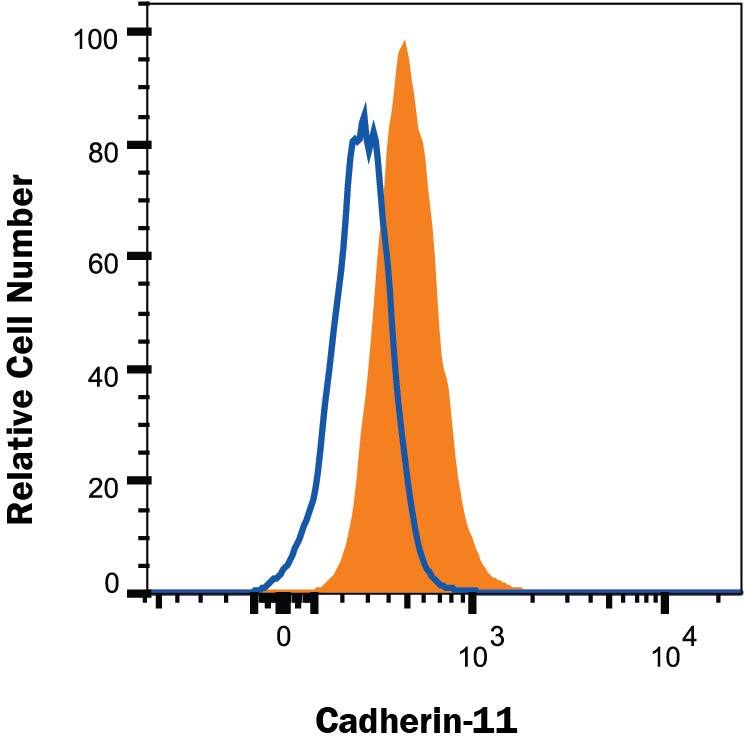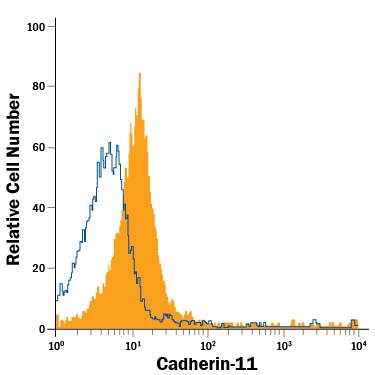Human Cadherin-11 PE-conjugated Antibody
R&D Systems, part of Bio-Techne | Catalog # FAB1790P


Key Product Details
Species Reactivity
Human
Applications
Flow Cytometry
Label
Phycoerythrin (Excitation = 488 nm, Emission = 565-605 nm)
Antibody Source
Polyclonal Goat IgG
Product Specifications
Immunogen
S. frugiperda insect ovarian cell line Sf 21-derived recombinant human Cadherin-11
Phe23-Thr617
Accession # AAA35622
Phe23-Thr617
Accession # AAA35622
Specificity
Detects human Cadherin-11 in direct ELISAs and Western blots. In direct ELISAs, approximately 10% cross-reactivity with recombinant human (rh) Cadherin‑12, 5% cross-reactivity with rhK-Cadherin, and less than 2% cross-reactivity with rhCadherin-8, rhE‑Cadherin, rhN‑Cadherin, rhP‑Cadherin, rhVE‑Cadherin, rhCadherin-13, and rhCadherin‑17 is observed.
Clonality
Polyclonal
Host
Goat
Isotype
IgG
Scientific Data Images for Human Cadherin-11 PE-conjugated Antibody
Detection of Cadherin‑11 in NCI-H460 Human Cell Line by Flow Cytometry.
NCI-H460 human large cell lung carcinoma cell line was stained with Goat Anti-Human Cadherin-11 PE-conjugated Antigen Affinity-purified Polyclonal Antibody (Catalog # FAB1790P, filled histogram) or isotype control antibody (IC108P, open histogram). Staining was performed using our protocol for Staining Membrane-associated Proteins protocol.Detection of Cadherin‑11 in PC‑3 Human Cell Line by Flow Cytometry.
PC-3 human prostate cancer cell line was stained with Goat Anti-Human Cadherin-11 PE-conjugated Antigen Affinity-purified Polyclonal Antibody (Catalog # FAB1790P, filled histogram) or isotype control antibody (Catalog # IC108P, open histogram). View our protocol for Staining Membrane-associated Proteins.Applications for Human Cadherin-11 PE-conjugated Antibody
Application
Recommended Usage
Flow Cytometry
10 µL/106 cells
Sample: PC‑3 human prostate cancer cell line and NCI-H460 human large cell lung carcinoma cell line
Sample: PC‑3 human prostate cancer cell line and NCI-H460 human large cell lung carcinoma cell line
Formulation, Preparation, and Storage
Purification
Antigen Affinity-purified
Formulation
Supplied in a saline solution containing BSA and Sodium Azide.
Shipping
The product is shipped with polar packs. Upon receipt, store it immediately at the temperature recommended below.
Stability & Storage
Store the unopened product at 2 - 8° C. Do not use past expiration date. Protect from light.
Background: Cadherin-11
References
- Pokutta, S. and W.I. Weis (2007) Annu. Rev. Cell Dev. Biol. 23:237.
- Kimura, Y. et al. (1995) Dev. Biol. 169:347.
- McCusker, C. et al. (2009) Mol. Biol. Cell 20:78.
- Clendenon, S.G. et al. (2009) Dev. Dyn. 238:1909.
- Kii, I. et al. (2004) J. Bone Mineral Res. 19:1840.
- Tamura, D. et al. (2008) Int. J. Oncol. 33:17.
- Chu, K. et al. (2008) Mol. Cancer Res. 6:1259.
- Huang, C.-F. et al. (2010) Cancer Res. 70:4580.
- Valencia, X. et al. (2004) J. Exp. Med. 200:1673.
- Kiener, H.P. et al. (2009) Arthritis Rheum. 60:1305.
- Monahan, T.S. et al. (2007) J. Vasc. Surg. 45:581.
- Boscher, C. and R.-M. Mege (2008) Cell. Signal. 20:1061.
- Tanihara, H. et al. (1994) Cell Adhes. Commun. 2:15.
- Okazaki, M. et al. (1994) J. Biol. Chem. 269:12092.
- Kawaguchi, J. et al. (1999) J. Bone Mineral Res. 14:764.
Alternate Names
Cadherin11, CDH11, CDHOB, OB-Cadherin
Gene Symbol
CDH11
UniProt
Additional Cadherin-11 Products
Product Documents for Human Cadherin-11 PE-conjugated Antibody
Product Specific Notices for Human Cadherin-11 PE-conjugated Antibody
For research use only
